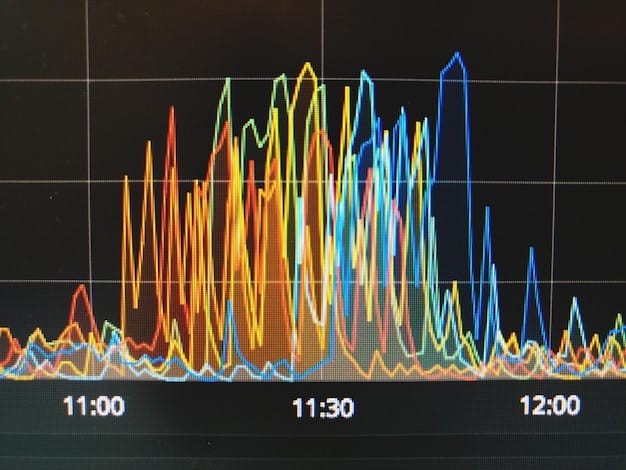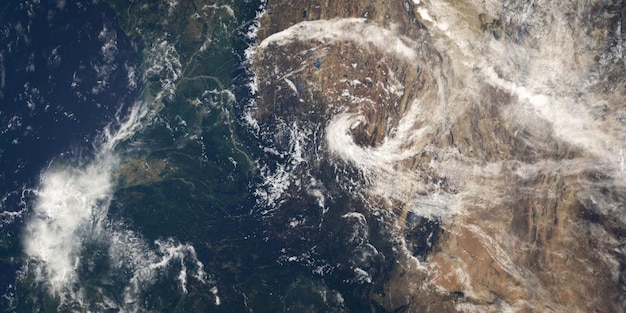Climate Change & Extreme Weather: Expect the Next 5 Years

**Climate change** is intensifying extreme weather events globally, leading to more frequent and severe heatwaves, droughts, floods, and storms, with projections indicating these trends will escalate over the next five years, impacting communities and ecosystems worldwide.
The **impact of climate change on extreme weather events** is becoming increasingly evident. What can we anticipate in the next five years regarding this pressing issue?
Understanding the Climate Change-Extreme Weather Connection
Climate change, driven by greenhouse gas emissions, is not just about rising average temperatures. It’s about the destabilization of weather patterns, leading to more intense and frequent extreme weather events. Understanding this connection is crucial for preparing for the future.
The relationship between climate change and extreme weather is multifaceted and complex. It involves changes in atmospheric circulation, ocean temperatures, and other factors that influence weather patterns across the globe.
Rising Temperatures and Heatwaves
One of the most direct impacts of climate change is rising global temperatures. This increase in temperature leads to more frequent and intense heatwaves, particularly in regions already prone to high temperatures.
The effects of these heatwaves can be devastating, leading to heatstroke, dehydration, and even death, especially among vulnerable populations such as the elderly and those with pre-existing health conditions.
Changes in Precipitation Patterns
Climate change is also altering precipitation patterns, leading to both more intense droughts and more severe floods. These changes can have significant impacts on agriculture, water resources, and ecosystems.
In some regions, increased evaporation due to higher temperatures is exacerbating drought conditions, leading to water scarcity and crop failures. In other regions, increased atmospheric moisture is resulting in more intense rainfall events and flooding.

- Heatwaves: Anticipate longer, more intense heatwaves, especially in urban areas.
- Droughts: Expect prolonged droughts in arid and semi-arid regions, impacting agriculture and water supplies.
- Floods: Be prepared for more frequent and severe flooding events in coastal and low-lying areas.
In conclusion, the connection between climate change and extreme weather is clear, with rising temperatures and altered precipitation patterns driving more frequent and intense events. Understanding these changes is essential for preparing for the challenges ahead.
Projected Increases in Heatwave Severity
Heatwaves are becoming more frequent and intense, posing significant risks to human health and infrastructure. Climate models predict that these trends will continue, with potentially deadly consequences.
The increased severity of heatwaves is attributable to the overall warming trend caused by climate change, coupled with changes in atmospheric circulation patterns. These factors combine to create conditions that favor the development and persistence of heatwaves.
Impact on Urban Areas
Urban areas are particularly vulnerable to heatwaves due to the urban heat island effect, where buildings and pavements absorb and retain heat, leading to higher temperatures compared to surrounding rural areas.
This effect can exacerbate the impacts of heatwaves, making urban areas even more dangerous during extreme heat events. Strategies such as increasing green spaces and using reflective building materials can help mitigate the urban heat island effect.
Health Risks and Vulnerable Populations
Heatwaves pose significant health risks, especially for vulnerable populations such as the elderly, children, and those with chronic health conditions. Heatstroke, dehydration, and respiratory problems are common during heatwaves.
Public health interventions, such as heatwave early warning systems and cooling centers, are essential for protecting vulnerable populations and reducing the health impacts of heatwaves.
Ultimately, heatwave severity is projected to increase. This necessitates proactive measures to protect urban areas and vulnerable populations, including implementing strategies to reduce the urban heat island effect and strengthening public health interventions.
The Growing Risk of Intense Precipitation and Flooding
Changes in precipitation patterns are leading to more intense rainfall events, increasing the risk of flooding in many regions. This poses challenges for infrastructure, agriculture, and public safety.
The link between climate change and intense precipitation is related to the fact that warmer air can hold more moisture. As temperatures rise, the atmosphere can hold more water vapor, leading to heavier rainfall events when storms occur.
Coastal Flooding and Sea Level Rise
Sea level rise, another consequence of climate change, is also exacerbating the risk of coastal flooding. Higher sea levels mean that storm surges and high tides can reach further inland, inundating coastal communities.
Coastal cities and towns are facing increasing challenges in adapting to sea level rise and the growing risk of coastal flooding. Strategies such as building seawalls and restoring coastal wetlands can help protect coastal communities.
Inland Flooding and Infrastructure
Inland flooding is also becoming more frequent and severe, overwhelming infrastructure such as roads, bridges, and drainage systems. Heavy rainfall events can cause rivers and streams to overflow, inundating surrounding areas.
Investing in infrastructure improvements, such as upgrading drainage systems and building flood control structures, is essential for reducing the risk of inland flooding and protecting communities.

- Infrastructure: Infrastructure damage leads to costly repairs and disruptions in services.
- Agriculture: Crop losses from extreme weather events impacting food security.
- Public Safety: Enhanced early warning systems is crucial for public safety.
In conclusion, the growing risk of intense precipitation and flooding poses significant challenges for communities around the world. Strategic investments in adaptation measures becomes very important.
More Frequent and Severe Droughts
While some regions are experiencing more intense precipitation, others are facing more frequent and severe droughts. These droughts have devastating impacts on agriculture, water resources, and ecosystems.
The increased frequency and severity of droughts are linked to rising temperatures and changes in precipitation patterns. As temperatures rise, evaporation rates increase, leading to drier conditions in many regions.
Impact on Agriculture and Food Security
Droughts can have severe impacts on agriculture, leading to crop failures and livestock losses. This, in turn, can threaten food security, especially in regions that rely on rain-fed agriculture.
Farmers are adapting to drought conditions by implementing water conservation measures, such as using drought-resistant crops and adopting irrigation techniques that minimize water use.
Water Scarcity and Ecosystems
Droughts can also lead to water scarcity, threatening both human populations and ecosystems. Reduced water supplies can lead to conflicts over water resources and can negatively impact the health of rivers, lakes, and wetlands.
Water management strategies, such as implementing water restrictions and investing in water storage infrastructure, are essential for mitigating the impacts of droughts and ensuring sustainable water supplies.
Ultimately, the frequency and severity of droughts have increased, impacting agriculture, water resources, and ecosystems. Effective drought management strategies are crucial for ensuring long-term sustainability.
Changes in Storm Patterns and Intensity
Climate change is affecting storm patterns and intensity, with some regions experiencing more frequent and severe storms. This poses significant challenges for coastal communities and infrastructure.
The relationship between climate change and storm intensity is complex and involves factors such as ocean temperatures and atmospheric circulation patterns. Warmer ocean temperatures provide more energy for storms to develop and intensify.
Hurricane and Cyclone Activity
Some studies suggest that climate change is leading to more intense hurricanes and cyclones, with higher wind speeds and heavier rainfall. These storms can cause catastrophic damage to coastal communities and infrastructure.
Coastal communities are preparing for more intense storms by strengthening building codes, improving evacuation plans, and investing in coastal protection measures.
Extratropical Storms and Nor’easters
Extratropical storms, such as nor’easters, are also being affected by climate change. Changes in atmospheric circulation patterns can lead to more frequent and intense nor’easters, bringing heavy snow and strong winds to coastal regions.
Communities in coastal regions are preparing for more frequent and intense extratropical storms by improving infrastructure and strengthening emergency response plans.
In conclusion, changing storm patterns and intensity pose significant challenges for coastal communities and infrastructure worldwide. Proactive preparedness and adaptation measures are crucial.
Mitigation and Adaptation Strategies
Addressing the impact of climate change on extreme weather events requires a combination of mitigation and adaptation strategies. Mitigation involves reducing greenhouse gas emissions, while adaptation involves adjusting to the effects of climate change.
Mitigation and adaptation are complementary strategies that are both essential for addressing the challenges posed by climate change. Mitigation can help slow down the rate of climate change, while adaptation can help communities cope with the impacts that are already being felt.
Reducing Greenhouse Gas Emissions
Reducing greenhouse gas emissions is crucial for slowing down the rate of climate change and reducing the frequency and intensity of extreme weather events. This can be achieved through measures such as transitioning to renewable energy sources, improving energy efficiency, and reducing deforestation.
Governments, businesses, and individuals all have a role to play in reducing greenhouse gas emissions. Implementing policies that promote renewable energy and energy efficiency can help drive down emissions.
Investing in Climate Resilience
Investing in climate resilience is essential for helping communities adapt to the impacts of climate change and reduce their vulnerability to extreme weather events. This can involve measures such as building flood control structures, restoring coastal wetlands, and implementing drought management strategies.
Communities can enhance their resilience to extreme weather events by strengthening infrastructure, improving emergency response plans, and promoting community-based adaptation strategies.
In conclusion, a combination of mitigation and adaptation strategies is essential for addressing the impact of climate change effectively. Mitigation can help slow down the rate of climate change, while adaptation can help communities cope with the impacts that are already being felt.
| Key Point | Brief Description |
|---|---|
| 🔥 Heatwave Severity | Projected increases in heatwave intensity, impacting public health and infrastructure. |
| 🌊 Intense Precipitation | Growing risk of flooding due to extreme rainfall events, affecting coastal and inland regions. |
| 🌵 Drought Frequency | More frequent droughts impacting agriculture, water resources, and ecosystems globally. |
| 🌪️ Storm Intensity | Changes in storm patterns and intensity impacting coastal communities and infrastructure. |
FAQ
▼
Climate change leads to rising temperatures and altered precipitation patterns, increasing the frequency and intensity of events like heatwaves, floods, and droughts.
▼
Coastal areas face sea level rise and intense storms, while arid regions are susceptible to drought. Urban areas intensify heatwave impacts.
▼
▼
This effect increases heatwave severity in cities due to buildings and pavements absorbing heat, leading to higher temperatures than rural areas.
▼
Individuals can create disaster plans, stay informed about weather alerts, secure their homes, and support climate mitigation efforts in their communities.
Conclusion
In summary, the **impact of climate change on extreme weather events** is expected to intensify over the next five years, necessitating urgent action to mitigate emissions and adapt to the changing climate. Proactive measures can protect communities.





